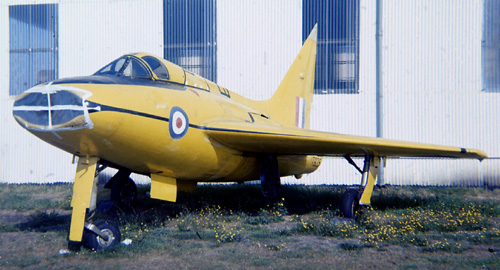|
| |
Back to Military
Miscellany
 |
The Auster AOP9 was the last in the famous
Auster series of single engined high wing light aircraft built in
Leicester by the Auster company. The AOP9 was designed as a
specialist battlefield observation and artillery spotting aircraft
for use by the British army. Despite being a very sound and robust
aircraft, it was a relatively easy target from the ground, so had a
relatively short service life. Several
have since found their way into private hands, including this one,
seen at Grenham Common in June 1981. |
 |
The Avro Shackleton was quite extraordinary.
It is essentially a modified and updated Lancaster, powered by four
Rolls-Royce Griffon piston engines driving contra-rotating
propellors. Fitted with airborne early warning (AEW) radar,
Shackletons provided Britain's AEW coverage from their base at
Lossiemouth in North Scotland until they were retired in 1990!!
This one was pictured at Finningley in 1976. |
 |
Boulton Paul (famous for the wartime Defiant)
built the P.111 immediately after the war as a research aircraft
into delta wings. It first flew in October 1950. Its single
Rolls-Royce Nene turbojet (5,100lb static thrust) gave it a top
speed of 650mph. It was a small machine, only 26 feet long, with a
wing span of 25 feet 8 inches. But, with military standard
construction and the very heavy engine, it weighed in at 10,200lb.
Data from the P111 was used in the design of the Vulcan heavy
bomber.
The only example is preserved in the museum at Baginton,
and was pictured there in August 1975. |
 |
The Fairey Gannet was a carrier-borne
anti-submarine aircraft, powered by a Bristol Double Mamba turboprop
- effectively two engines joined together and driving a
contra-rotating propellor through an elaborate gearbox. Despite
looking as if it couldn't possibly fly, it was actually very good at
its job! After being replaced by helicopters for the anti submarine
warfare role, several were converted to carry airborne radar in the
AEW role, until the retirement of the Royal Navy's last serious
aircraft carriers rendered them obsolete.
This one is a Gannet AEW3, date and place
uncertain. |
|
|
The Hawker Siddeley Nimrod was a development
of the De Havilland Comet for the maritime reconnaisance role. It
added a second `bubble' below the main fuselage to house radar,
systems and weapons bay, a fin strake for stability, magnetic
anomaly detector behind the tail and electronic warfare pod on top
of the fin. It could loiter on patrol for huge amounts of time.
In one encounter with a Tornado, the Tornado
pilot gave a display, then challenged the Nimrod to do something the
Tornado couldn't. The Nimrod carried on flying as before. The
Tornado pilot repeated his challenge. `I've just done it', replied
the Nimrod pilot. `I've turned off three of my engines.'
Top - Nimrod MR1 at Bournemouth in August 1984.
Bottom - Nimrod MRA2 at Fairford, July 2007 |
 |
The Saro SRA1 was one of a collection of
bizarre one-off research aircraft produced in the 1950s. It is
unusual in being a jet seaplane. It does not take too much
imagination to see why the trials were not successful; spray could
easily enter the air intake and cause the engine to flame out.
The SRA1 has been preserved, and was pictured at
Duxford in June 1984. |
|
|
The Westland Lysander was designed during the
second world war as a light liaison aircraft, but really won its
fame in `clandestine operations'. It was fitted with a Bristol
Mercury engine which was really too powerful, enabling it to be
flown at very low power settings, i.e. quietly. Its huge
ungainly-looking undercarriage and bat-like wings gave it superb
performance into and out of rough fields. Many insurgents were
landed in occupied France, and many fugitives picked up and brought
to safety, by Lysander operations. This
one is kept in airworthy condition and was pictured at Old Warden in
1997. (lower photograph - same aircraft in 2005). |





|